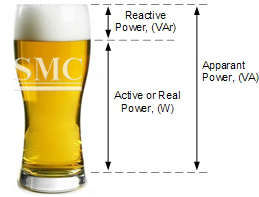Reactive power (VAR) compensation is defined as the management of reactive power to improve the performance of ac systems. There are two aspects:
1. Load Compensation
The main objectives are to:
· To increase the power factor of the system
· To balance the real power drawn from the system
· To compensate voltage regulation
· To eliminate current harmonics
2. Voltage Support
The main purpose is to decrease the voltage fluctuation at a given terminal of transmission line. Therefore the VAR compensation improves the stability of ac system by increasing the maximum active power that can be transmitted.
What is reactive power?
Force is alluded as the result of voltage and current i.e. power = V x I The bit of power that builds up and manages the electric and attractive fields of rotating current hardware. Responsive force must be supplied to most sorts of attractive hardware, for example, engines and transformers. In an air conditioner transmission, when the voltage and current go all over in the meantime, just genuine force is transmitted and when there is a period shift amongst voltage and current both dynamic and responsive force are transmitted.
In many ways, reactive power can be thought of like the foam head on a pint or glass of beer. You pay the barman for a full glass of beer but only drink the actual liquid beer which is always less than a full glass.
This is because the froth of the beer takes up additional wasted space in the glass leaving less room for the real beer that you consume, and the same idea is true for reactive power.

Why do we need reactive power?
In resistive burdens the present delivers the warmth vitality which delivers the coveted yield yet if there should be an occurrence of inductive burdens the current makes the attractive field which facilitate produces the craved work. In this way responsive force is the non working force brought on by the attractive current to work and manage attraction in the gadget. Responsive force (vars) is required to keep up the voltage to convey dynamic force (watts) through transmission lines. At the point when there is insufficient responsive force the voltage droops down and it is impractical to convey the obliged energy to stack through the lines.Need for Reactive Power Compensation
Reactive power generated by the ac power source is stored in a capacitor or a reactor during a quarter of a cycle and in the next quarter of the cycle it is sent back to the power source. Therefore the reactive power oscillates between the ac source and the capacitor or reactor at a frequency equals to two times the rated value (50 or 60 Hz). So to avoid the circulation between the load and source it needs to be
Methods of Reactive Power Compensation
Shunt compensation
The device that is connected in parallel with the transmission line is called the shunt compensator. A shunt compensator is always connected in the middle of the transmission line. It can be provided by either a current source, voltage source or a capacitor.
Synchronous condensers
The devices use synchronous voltage sources for generating or absorbing reactive power. A synchronous voltage source (SVS) is constructed using a voltage source converter (VSC).
Static VAR compensators
A static VAR compensator (or SVC) is an electrical device for providing reactive power on transmission networks. The term “static” refers to the fact that the SVC has no moving parts (other than circuit breakers and disconnects, which do not move under normal SVC operation). The SVC is an automated impedance matching device, designed to bring the system closer to unity power factor. If the power system’s reactive load is capacitive(leading), the SVC will use reactors (usually in the form of thyristor-Controlled Reactors) to consume vars from the system, lowering the system voltage. Under inductive (lagging) conditions, the capacitor banks are automatically switched in, thus providing a higher system voltage.
Shunt compensation
Shunt-connected reactors are used to reduce the line over-voltages by consuming the reactive power, while shunt-connected capacitors are used to maintain the voltage levels by compensating the reactive power to transmission line.
Series compensation
When a device is connected in series with the transmission line it is called a series compensator. A series compensator can be connected anywhere in the line. There are two modes of operation – capacitive mode of operation and inductive mode of operation. A simplified model of a transmission system with series compensation is shown in Figure .The voltage magnitudes of the two buses are assumed equal as V, and the phase angle between them is δ.
Overall, from all the previous discussion we can conclude reactive power compensation is a must for improving the performance of the ac system. By reactive power compensation we can control the power factor and reduce the consumption of electricity.
Shanghai Metal Corporation is a trusted aluminum alloy, aluminum foil price, stainless steel price and stainless steel manufacturer, kinds of stainless steel in china.
Guest contributors are welcome at the Alloy Wiki.It is a weekly wiki and guide on alloy information and processing technology, while also about the vast array of opportunities that are present in manufacturing. Our team of writers consists of a Machining Material Supplier / Machinist / Tool and Die Maker, a Biomedical Engineer / Product Development Engineer, a Job Development Coordinator / Adjunct Professor, and a President and CEO of a manufacturing facility.
Link to this article:Reactive power compensation
Reprint Statement: If there are no special instructions, all articles on this site are original. Please indicate the source for reprinting:Alloy Wiki,thanks!^^


